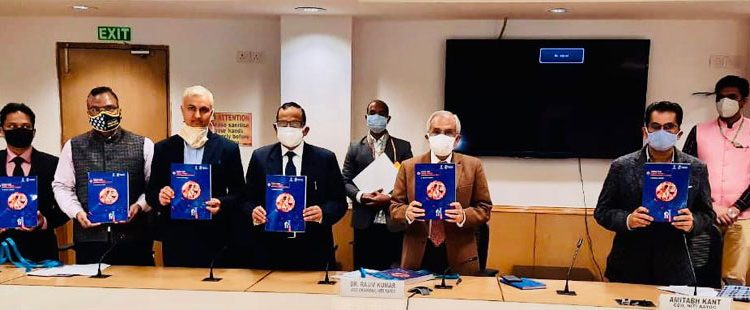New Delhi (Kalinga Voice): NITIAayog today released a white paper – Vision 2035: Public Health Surveillance in India, with the objective of making the health surveillance system more responsive & predictive to enhance preparedness for action at all levels. The white paper lays out India’s vision for public health surveillance through the integration of the three-tiered public health system into Ayushman Bharat. It also spells out the need for expanded referral networks and enhanced laboratory capacity. The building blocks for this vision are an interdependent federated system of governance between the Centre and states.
The white paper was released by NITI Aayog Vice Chairman Dr Rajiv Kumar, Member (Health) Dr. Vinod K Paul and CEO Amitabh Kant . As the scope of the Vision 2035 the white paper says ” This is a vision document for public health surveillance in India in 2035. The document defines the vision, illustrates the architecture, describes the proposed flow of information, lists key questions and considerations that are necessary to expand the scope of Public Health Surveillance in India, defines the four building blocks and lists possible steps towards achieving the vision.
The vision document briefly describes the progress made by India in Public Health Disease Surveillance and builds on the existing experience of public health surveillance systems with a focus on governance that is based on cooperative federalism, fostering the involvement of State Governments and using a bottoms-up approach. It aligns with inclusive and sustainable growth and the principles stated in the National Health Policy . These include human resources that practice professionalism, integrity and ethics, and public health services that reduce inequity and catastrophic costs for health care.
It is further mentioned “The focus is on Universal Health Coverage and patient-centered quality of care that is gender-sensitive, effective, safe, convenient and provided with dignity and confidentiality. The multistakeholder approach with partnership and participation of all non-health ministries and communities including academic institutions, not for profit agencies, and the health care industry, pluralism to optimise services wherever patients first seek care, decentralization of decision making, citizen centricity, and focus on expansion of Public Health Surveillance to include non-communicable and occupational diseases, including mental health are all touched upon. In addition to building on India’s past experience, the document draws on lessons learned from global best practice including examples from Thailand, Taiwan, Germany, the United Kingdom, the United States of America and Canada.
The document does not include funding and budget requirements. The analysis of the capacity of existing institutions is based on reviews of evaluation reports. The document excludes a focus on COVID-19, even though India’s capacity and resilience have been challenged by this pandemic. COVID-19 is a great example of the country’s rapid response
to a public health emergency of international concern, and its own capacity to accelerate laboratory capacity, and to digitise, analyse and use information for action. Instead, the document focuses on expanding surveillance to be inclusive of non-communicable diseases, occupational, injury and environmental conditions in a One-Health approach for Public Health Surveillance.
Next steps include the creation of a road-map or blueprint for action. As well, it would be important to set up effective and responsive governance mechanisms that establish political, technical, digital and managerial leadership in order to enable India reach this vision by 2035.”

